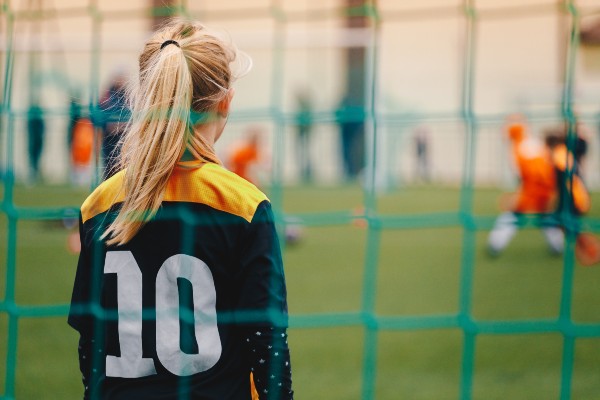
Free Consultation(203) 447-0000

Free Consultation(203) 447-0000

Recent studies focusing on the prevalence and effects of sports-related concussions among female and male athletes have produced some notable findings. Overall, these studies suggest that female athletes experience sports-related concussions at significantly higher rates than male athletes. They also suggest that female and male athletes’ brains may respond to concussions differently.
For example, a 2019 study titled, Concussion Incidence and Trends in 20 High School Sports, published in the journal Pediatrics, found that:
“Among sex-comparable sports, concussion rates were higher in girls than in boys (3.35 vs 1.51 per 10[,]000 [athlete exposures]). Also, among sex-comparable sports, girls had larger proportions of concussions that were recurrent than boys . . . .”
An article on Forbes.com discussed this study, highlighting that female soccer players and male football players suffer sports-related concussions at roughly the same rates. However, while the data is clear, there is still controversy surrounding why girls suffer more concussions than boys.
The Concussion Incidence and Trends in 20 High School Sports study examined the prevalence of concussions during competitions and practice in female-only and male-only sports. Doing so sheds light on some important differences between female and male sports and athletes that should help inform concussion-related research and protocols going forward. For example, the study found that:
These recent data contrast with data from a decade ago. An article published in Psychology Today notes that a 2012 study found that nearly half (47.1 percent) of all high school sports concussions were suffered by football players. At the time, female soccer players still accounted for the next-highest percentage, but still just 8.2 percent.
Whether the change in percentages from 2012 to 2019 is attributable to changes in the prevalence of concussions among various sports or changes in the reporting of sports-related concussions is unclear. However, a recent article published in Clinical Sports Medicine, titled Female Athlete and Sports-Related Concussions, notes that “[f]emale athletes are participating in collision sports in greater numbers than previously[.]” The article goes on to say that “[t]he overall incidence of concussion is known to be higher in female athletes than in male athletes participating in similar sports.”
There is also evidence to suggest that there are differences in how female and male athletes’ brains respond to concussions. For example, Johns Hopkins Medicine writes:
“There is some evidence that female athletes and male athletes respond differently to concussions. Studies have shown that female athletes who sustain concussions are more likely to have more severe and longer-lasting symptoms than male athletes.”
As far as why this may be the case, Johns Hopkins Medicine hypothesizes that “Women may experience more severe and longer-lasting concussion symptoms than men due to smaller neck size and therefore lower neck strength[.]” However, the piece also noted that “there is little research on the reasons for more severe and longer-lasting symptoms in female athletes [and] gender issues in concussions are still a relatively understudied topic.”
Similarly, Female Athlete and Sports-Related Concussions notes “Evidence suggests anatomic, biomechanical, and biochemical etiologies behind this sex disparity.” But, “[f]uture research on female athletes is needed for further guidance on prevention and management of concussion in girls and women.”
An article published by the BBC discusses the differences in female and male athletes’ responses to sports-related concussions in greater detail. Citing various sources, the BBC writes that:
“While male concussions are more likely to be followed by amnesia, for instance, female ones are more likely to lead to prolonged headaches, mental fatigue and difficulties with concentration, and mood changes.
“Female athletes also seem to require more time for those symptoms to disappear. One study of 266 adolescents – including soccer and American football players, wrestlers and skiers – found that, on average, females took 76 days to recover, while males took 50 days.”
Regardless of an athlete’s gender, studies show that sports-related concussions can have lasting effects. As a result, leaders in all sports must take steps to reduce the risk of concussions for participating athletes. So, what can be done?
Education is a key factor. By educating coaches, trainers, athletes, and parents about concussion-related risks, teams, and leagues can significantly reduce the risk of concussions—as well as the risk that athletes will continue to participate after being concussed. As researchers continue to study both the short-term and long-term effects of sports-related concussions, there is likely to be even more information to share.
Teams, leagues, and individuals that ignore the risks of concussions for athletes also need to be held accountable. Accountability is essential for enforcing the legal and moral obligation to protect athletes against unnecessary risks. Athletes and families will be able to pursue legal claims in many cases. In addition to providing athletes and families with financial compensation, pursuing such claims can serve an important deterrent function.
The Connecticut sports concussion lawyers at Berkowitz Hanna represent athletes and families in cases involving concussions sustained during youth, amateur, and professional sports. If you have questions and would like to speak with a lawyer, Contact us online for a free and confidential consultation.
Berkowitz Hanna
